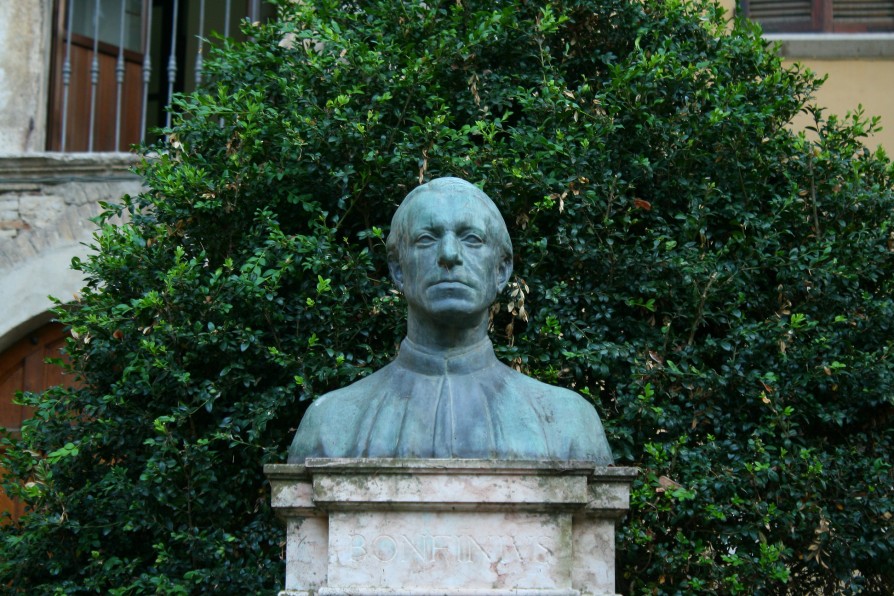
- On 29/01/2022
- In Montaltesi EN
- Tags:
THE BONFINI FAMILY
THE BONFINI FAMILY
Among the most prolific families of intellectuals and artists of the Montalto territory, the Bonfini were the “ancient dynasts of the land of Patrignone”, or rather the lords of the castle, recorded in the thirteenth century under the rule of Ascoli, Patrignone was ceded as a fief* to the Bonfini family. The forefather of the family was Achille Bonfini. For Patrignone the fifteenth and sixteenth centuries were the most significant, producing monuments and characters of considerable calibre, almost all of which were linked to the noble Bonfini family. The Bonfini’s wealth enabled them to cultivate the arts, study law and emerge in medicine and literature. The most famous exponent of the family was certainly Antonio Bonfini, Achille’s nephew, born in 1427. He was a humanist scholar. After various assignments as tutor to the noblest families of Ferrara, Rome, Padua and Florence, he probably came into contact, in 1476 in Loreto, with Beatrice of Aragon, wife of Mattia Corvino, king of Hungary. After 10 years from this first meeting, spent as professor at the Recanati academy, he presented his Latin translations of some Greek works and some of his original writings (Symposium sive de virginitate et pudicitia coniugali and a Historia Asculana) to the Hungarian royal family. Mattia Corvino, fascinated by Antonio’s knowledge, decided to appoint him as court historiographer, entrusting him with the translation of some Latin writings and the powerful drafting of a history of the Hungarians. The writing of the Rerum Ungaricum Decades occupied him until his death in 1502. The work follows the model inaugurated by Tito Livio for the drafting of the history of Rome and it consists of five decades ranging from the barbarian people of the Hungarians up to the end of 1496. The work is the basis of Hungarian historiography and one of the greatest examples of humanistic literature in this field.
Another leading figure of the family was Giacomo Bonfini, Antonio’s son, born in 1470. The continuous travels with his father between Italy and Hungary allowed him to acquire a solid humanistic education. There is no certain information on his artistic apprenticeship, but deep analysis of his works reveals a marked influence by Umbrian-Marche art of the late fifteenth century, with several references to the work of Cola dell’Amatrice and in general to works of Perugian origin. Among his most famous works is the pictorial cycle of the Oratory of the Madonna della Misericordia in Tortoreto (TE). In the Montalto area, the fresco in the crypt of the church of S. Lucia (in Porchia) depicting the Nativity stands out, as well as those made in Patrignone for the churches of S. Maria in Viminatu and of the Annunziata.
Among Giacomo’s nephews is Martino Bonfini, born in 1565 in Patrignone. Martino was a very prolific painter, also with works in Piedmont. He dedicated to trips to the capitals of Italian art, in which he learned the main novelties of sixteenth-century painting. In fact, in his paintings it is possible to see the Manneristic influence of Correggio and Parmigianino from Parma, as well as that of Federico Zuccari from Urbino (and active in Rome). Among his most famous works are the cycle of the Stories of the Virgin in the Santuario della Madonna dell’Ambro in Montefortino, the Marian cycle in the Church of S. Maria in Pantano and the monumental altar in the Church of SS. Crocifisso in Monterubbiano. In Patrignone, it is possible to admire some of his paintings in the church of S. Maria in Viminatu.
Among the works of another Bonfini, Desiderio, a sculptor and wood carver, the tabernacle of the parish church of Patrignone bears testimony to his skill.
- fief (something over which one has rights or exercises control)